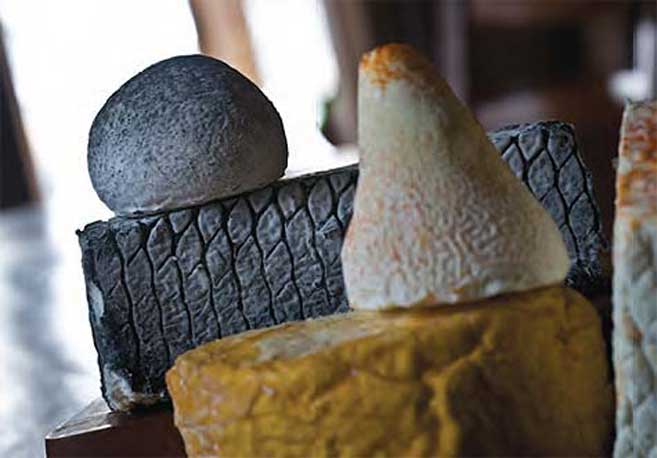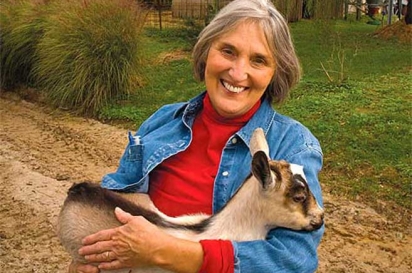Queen of Cheese
Decades of trial and tasting produce award winning Capriole line.
Wabash Canonball’s slightly wrinkled exterior and creamy/dry interior is the culinary equivalent of Wendell Berry’s prose, expressing itself with elegance but utmost simplicity. It brings so much to the plate.
With the bright white and slightly gray cheese, fresh goat cheese flavor, a thin layer of ash and, when it’s perfect, a thin, runnier translucent layer surrounding it all, a bite can be something delicious. Or it can be the first hint of the history and hard work it takes to create a product that reflects in one taste where it has come from, and where American cuisine has the potential to go, if we are careful.
A little goat milk and a few geotrichum spores, how hard can it be?
Judith Schad, who owns the Southern Indiana company Capriole, began making goat cheese in the early ’80s when she got tired of throwing the milk from her children’s show goats down the drain.
She started with a few experiments in her kitchen, attended conferences and sought advice from Laura Chenel, who was making fresh goat cheese in Northern California. In the mid-’80s she traveled to Massachusetts and spent a week or so at Westfield Farm with Letty Kilmoyer, who had been making goat cheese since the 1970s.
Schad’s cheeses, like Chenel’s, were all creamy and fresh: milk, coagulant, sometimes herbs. As she got serious, she left her kitchen and took her milk down the road to Huber’s Orchard and Winery in Starlight, which had commercial cheese-making equipment. Nancy Tarrant at the Cheddar Box in St. Matthews began to sell these fresh cheeses so the public began to taste them. In 1988, Capriole Farm was launched and Schad started the journey that would take her from fledgling cheese maker to People-magazine famous.
It wasn’t a straightforward journey. In 1988, fewer than 350 cheeses were entered in the annual contest of the American Cheese Society. “Maybe not that many,” Schad qualifies. “It was a handful of us in a 40- by 20-foot room and half of the room was cheeses. Now they have special hotels” to hold the conferences, she says—and last year 1,300 cheeses were judged.
The handful of pioneer cheese makers, including Schad’s peers Paula Lambert of the Dallas-based Mozzarella Company (founded in 1982) and Mary Keehn of Cypress Grove in Northern California (founded in 1983) were struggling not only against a common assumption that cheese was supposed to be flat, rubbery and individually wrapped, but against an agricultural establishment that preferred big to small, standard to inventive and where “dairy” means “cow.” They learned by turning to each other for information.
In France, there are entire experimental stations given over to goat dairy research, testing the progeny of bucks who are used for artificial insemination, attempting to increase the protein in the milk, measure how fast a doe will milk and so on. Goat cheese makers can select genetics. “We don’t have anything like that here,” says Schad. “Here what we have is a breed registry” that describes physical characteristics of breeds: not much help when you want to make cheese for a living.
In Europe, says Schad, there’s an educational support system and “200 to 300 years of history. I had to learn by trial and error.” She called other cheese makers around the country for advice. She went to regular meetings of cheese makers. And she ate lots and lots of bad cheese. “We would follow behind the judges, listening to their comments and tasting everything, the good and the bad,” she says. Ammoniated, metallic, musty and flat cheeses taught her as much as the Best in Show.
Even as she was learning to make great cheese, she couldn’t get comfortable. As fresh goat cheese became more acceptable to an increasingly sophisticated American public, competition became a factor. Fresh cheeses imported from countries that subsidized its production tasted just fine and cost much less than fresh American goat cheese. Folks like Steve Jenkins, author of The Cheese Bible, advised Schad to make something original, something exclusive. “I didn’t want to hear it,” says Schad “and I was really mad at [him].”
But hear it she did, and it started her on a course of cheese making that reflected her own region, from the milk to the names of the cheeses. Early on, Schad made a Banon, named after and modeled on a similar cheese in France, but what author Jenkins described as “much, much better than any I’ve tasted in France.” Today, the cheese is wrapped in chestnut leaves that have been soaked in Woodford Reserve bourbon, tied with raffia and called O’Banon, after the late Indiana governor, Frank O’Bannon. The cheese has won four first places and a second over the years at the American Cheese Society competition, including a first place last year.
The step after fresh chevres is a ripened cheese, says Schad, the kind of cheese that has mold on the outside and ripens inward.
In 1992 she made the Wabash Cannonball named for the fictional train sung about by the Carter family, and modeled on French ripened cheeses. This mild-tasting cheese won Best of Show at the cheese society’s competition, and was later featured in The Cheese Plate, a book written in 2002 by Max McCalman, who established the cheese programs at Artisanal Brasserie & Fromagerie restaurant, followed by the Artisanal Cheese Center in New York City.
At the same time Schad was experimenting with aged, raw-milk cheeses that would dismay anyone who had spent a decade uttering the words, “I don’t like goat cheese.” These resembled nothing that had been available at cheese counters before. Named for a Southern Indiana monastery, Mont St. Francis is a washed rind cheese in the same family with Pont l’Eveque and Epoisse—stinky, rich, earthy, yummy.
Old Kentucky Tomme is another aged, raw-milk cheese with a strong flavor, mushroomy and nutty. When the tomme is young it has a powdery white rind, which wrinkles and darkens as the cheese ages and gets hard. Jenkins designated these two aged cheeses, the Cannonball and the O’Banon all “American Treasures,” forging a new path for cheese makers. Today, Schad makes more than a dozen different cheeses.
These are not cheeses made on the heels of long American food traditions. Schad had to figure out what sort of aged cheese she wanted to make and then dive in, more or less by herself. “I didn’t want to make a really soft Epoisse because you can’t hold them 60 days and I wanted to make them out of raw milk,” she says. To decide what she did want to make, she said, “you read books, you go to France, you go where they’re making it and you eat as much as you possibly can. You poke your nose in other people’s business.”
While Schad’s cheese selection has stayed the same over the last 7 to 8 years, much else is changing. There was a time when she kept about 175 goats and bought milk from other farmers. Problems with the supply, however, have led her to close the system at her farm. There are now about 500 goats on the property, with 225 to 325 being milked, depending on the season.
She must make sure the animals live in a low-stress environment, with ample room to move around, ample feed so there’s no competition, ample fresh water and hay.
The Schads (her husband, Larry, is a lawyer in New Albany) just added 100 feet out the back of their barn so the goats have more room. The goats are milked twice a day by interns Schad hires through an Ohio State University program. Most of the interns come from Europe, occasionally they come from Asia and South America.
The Schads moved to the farm from a suburb in New Albany in order to have gardens, and maybe a cow. After they bought the farm, they discovered the home had belonged to Larry’s great, great grandfather in the 1870s. They bought goats as 4-H projects for her 3 children.
All of it—the history, the family, the land, hard work, healthy animals—contributes to Schad’s success as the person whom Saveur magazine said “helped kick-start a Midwestern artisanal-cheese movement.” And it may be food like a simple, straightforward ripened cheese that won Best of Show in 1995, and has never been entered again, that helps lay the groundwork for great American cuisine, if we take stock of our history and our land and take care of our resources.






